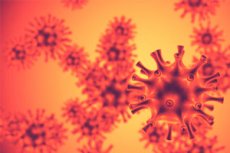Nye publikasjoner
Medikamentlignende hemmer viser lovende resultater i forebygging av influensa
Sist anmeldt: 02.07.2025

Alt iLive-innhold blir gjennomgått med medisin eller faktisk kontrollert for å sikre så mye faktuell nøyaktighet som mulig.
Vi har strenge retningslinjer for innkjøp og kun kobling til anerkjente medieområder, akademiske forskningsinstitusjoner og, når det er mulig, medisinsk peer-evaluerte studier. Merk at tallene i parenteser ([1], [2], etc.) er klikkbare koblinger til disse studiene.
Hvis du føler at noe av innholdet vårt er unøyaktig, utdatert eller ellers tvilsomt, velg det og trykk Ctrl + Enter.

Influensamedisiner som er tilgjengelige i dag, angriper bare viruset etter at det allerede har etablert en infeksjon, men hva om et legemiddel kunne forhindre infeksjon i utgangspunktet? Nå har forskere ved Scripps Institute og Albert Einstein College of Medicine utviklet legemiddellignende molekyler som kan gjøre nettopp det, og forstyrre den første fasen av en influensainfeksjon.
Disse hemmerne blokkerer viruset fra å komme inn i kroppens luftveisceller ved å spesifikt målrette hemagglutinin, et protein på overflaten av influensa A-virus. Funnene, publisert i tidsskriftet Proceedings of the National Academy of Sciences, representerer et viktig skritt fremover i utviklingen av et legemiddel som kan forhindre influensainfeksjon.
«Vi prøver å målrette oss mot det aller første stadiet av influensainfeksjon, da det ville være bedre å forhindre infeksjon i utgangspunktet, men disse molekylene kan også brukes til å hemme spredningen av viruset etter infeksjon», sier hovedforfatter av studien Ian Wilson, DPhil, professor i strukturbiologi ved The Scripps Institute.
Inhibitorene trenger ytterligere optimalisering og testing før de kan evalueres som antivirale midler hos mennesker, men forskerne sier at molekylene etter hvert kan bidra til å forebygge og behandle sesonginfluensainfeksjoner. Og i motsetning til vaksiner, trenger inhibitorene sannsynligvis ikke å oppdateres hvert år.
Forskerne identifiserte tidligere et lite molekyl, F0045(S), med begrenset evne til å binde seg til og hemme H1N1-influensavirus.
«Vi startet med å utvikle en høykapasitets hemagglutininbindingsanalyse som tillot oss å raskt screene store biblioteker av små molekyler og fant hovedforbindelsen F0045(S) ved denne prosessen», sa hovedforfatter av studien Dennis Wolan, PhD, seniorforsker ved Genentech og tidligere førsteamanuensis ved The Scripps Institute.
I denne studien forsøkte teamet å optimalisere den kjemiske strukturen til F0045(S) for å lage molekyler med bedre legemiddellignende egenskaper og mer spesifikk evne til å binde seg til viruset. Til å begynne med brukte Wolan-laboratoriet «SuFEx klikkkjemi», utviklet av den to ganger nobelprisvinneren og medforfatteren K. Barry Sharpless, PhD, for å lage et stort bibliotek med kandidater med forskjellige variasjoner av den opprinnelige F0045(S)-strukturen. Ved å skanne dette biblioteket identifiserte forskerne to molekyler – 4(R) og 6(R) – med overlegen bindingsaffinitet sammenlignet med F0045(S).
Wilsons laboratorium laget deretter røntgenkrystallstrukturer av 4(R) og 6(R) bundet til influensahemagglutininproteinet for å identifisere bindingsstedene til molekylene, mekanismene bak deres overlegne bindingsevne og områder for forbedring.
«Vi viste at disse inhibitorene binder seg mye tettere til det virale hemagglutinin-antigenet enn det opprinnelige hovedmolekylet», sier Wilson. «Ved hjelp av klikkkjemi utvidet vi faktisk forbindelsenes evne til å samhandle med influensa ved å få dem til å målrette ytterligere lommer på overflaten av antigenet.»
Da forskerne testet 4(R) og 6(R) i cellekultur for å bekrefte deres antivirale egenskaper og sikkerhet, fant de at 6(R) var giftfri og hadde mer enn 200 ganger forbedret antiviral aktivitet i celler sammenlignet med F0045(S).
Til slutt brukte forskerne en målrettet tilnærming for å optimalisere 6(R) ytterligere og utvikle forbindelse 7, som viste enda bedre antiviral aktivitet.
«Dette er den mest potente småmolekylære hemagglutininhemmeren som er utviklet til dags dato», sa hovedforfatter av studien Seiya Kitamura, som jobbet med prosjektet som postdoktor ved The Scripps Institute og nå er assisterende professor ved Albert Einstein College of Medicine.
I fremtidige studier planlegger teamet å optimalisere forbindelse 7 ytterligere og teste inhibitoren i dyremodeller av influensa.
«Når det gjelder potens, vil det være vanskelig å forbedre molekylet, men det er mange andre egenskaper som må vurderes og optimaliseres, som farmakokinetikk, metabolisme og vannløselighet», sier Kitamura.
Fordi hemmerne som er utviklet i denne studien kun retter seg mot H1N1-influensastammer, jobber forskerne også med å utvikle lignende hemmere for andre influensastammer, som H3N2 og H5N1.
